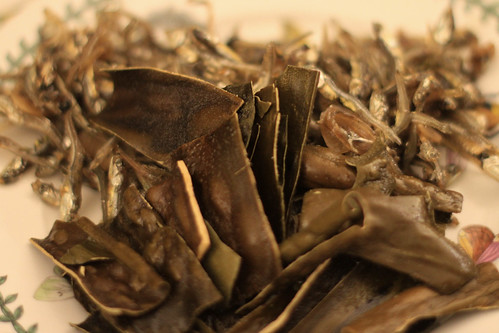Just about any Korean table will be set with a variety of banchan, which sort of translates as "side dishes" but is more than that . Even more than "main dishes," it's the fermented condiments, the braised vegetables, the stir-fried fish, and all sorts of other nibbles that form the heart and soul of the cuisine. Such variety, ranging from spicy to funky to mild to crunchy, allows the diner to choose their own adventure through the course of the meal.

Some banchan are super-easy to make, whereas others take hours of labor and weeks of advance preparation. Most banchan keep well, so households that's eating this way on the regular will make their favorites on a rolling basis as they run low (or simply buy it from the store). Since I haven't made Korean food in years and I insist on making as much as I can from scratch, it took a long time to make it all, which I paced over several days.
A two-part note on why, as an alphabetically-organized project, we fit a meal from South Korea between Peru and the Philippines. One, in the UN member list, it’s classified under R for Republic of Korea, so it’s not that far off. (North Korea was under D, for Democratic People’s Republic of Korea.) And two, we moved it up a few notches so we could have the meal during the Opening Ceremonies in Pyeongchang — and it also happened to fall right around the Korean New Year, so we made two dishes special to the occasion.

Big thanks to John, who lived in Seoul for a while, and brought both kimchi pancakes and some soju. And it was great to have Eunju's perspective, comparing the flavors to the ones she grew up with. Our other guests were Monica, Andrew, Laura, Craig, Julia, Liz, Elia, Jeff, Chelsea, Pan, and Orion.

Dasima twigak | Fried kelp | Recipe

I’ve never tasted anything like this, certainly not with this much flavor for so few ingredients. These fairly thick pieces of seaweed, which would be really tough and unpleasant to gnaw on raw, puff and crisp after just about a minute in hot oil and a sprinkling of sugar, you’ve unlocked the briny, umami-laden flavor of the ocean in every nibble. This is just the perfect thing to get your appetite going -- especially because they’re so intense, it’s hard to gorge on them!
Myulchi bokkeum | Stir-fried dried anchovies | Recipe
Anchovies are a somewhat more familiar way to snack on the sea, for sure, but this preparation and especially the blend of flavors threw me for a different sort of loop. It's sweet with honey, punchy with garlic, and savory with soy and rice wine, along with the intensity of some really small semi-dried fish. The texture is equally trippy, a fairly sticky sauce on top of slightly chewy and quite crunchy little swimmers. But for all of that, it was impossible to resist snacking on one or two every time I walked by the plate while cooking!
Kkaetnip Jangajji | Pickled shiso leaves | Recipe

I’m a big fan of shiso leaves, which are apparently also known as perilla. They’ve got a flavor somewhere between mint and basil, which you may have tasted as a little garnish at a higher-end sushi restaurant. Here, they’re pickled in a simple soy sauce and vinegar. It was worth a shot, but I found those flavors to overpower the aromatics in the leaf. Oh well!
Tongbaechu kimchi | Classic cabbage kimchi | Recipe

I know precious little about Korea, and this is only the second time I’ve ever cooked Korean food, but I did know that we’d have to have kimchi, and that I’d have to make it in advance to allow time to ferment.
Now that I’ve made it, I understand why, despite being primarily based on a very inexpensive ingredient, kimchi isn’t very cheap. There’s a lot of ingredients, a lot of steps, and some careful labor involved.
Among the twenty or so ingredients this recipe were a fermented brine of the tiniest little shrimp, and a vegetable I’d never heard of called water dropwort. You have to salt and squeeze the cabbage, julienne radish and carrots, make a porridge out of glutinous rice powder, mix everything with two cups (!!) of chili powder, and then diligently rub the goop in between every single cabbage leaf. It took me a good 90 minutes or so to put this all together, while a batch of dill pickles would only take five to ten minutes to assemble. Thank goodness I decided to make the full recipe of three cabbages, to make the most of the effort.
Most kimchi recipes say to let it sit out for a few days “until it’s ready” before refrigerating. I hadn’t thought a ton about it, and then I came home one day to the house smelling funky in a novel way. It took me a few minutes to remember that I had kimchi going! It then went into the fridge for another week of maturing until the meal.
Guys, this was some really good kimchi. The stalks keep some crisp, the flavors are complex, the fermenty smell real but not at all overpowering, and the spice surprisingly balanced despite the tremendous amount. Even after giving some away to friends and guests, I have a good six cups or so remaining, which I’m looking forward to using as it ages -- I hear tell there’s a good soup for mature kimchi!
Kkakdugi | Radish kimchi | Recipe
The paste-rubbed cabbage kimchi is only one of a constellation of fermented condiments under that name. Another common kind is made with so-called Korean radish, which is different from daikon: it’s shaped like a top and has the firmness of a turnip, but is really big, like, most are well over a pound.
This one was substantially easier to make, both because it’s a simpler spice/flavor paste, and also because it’s as simple as mixing up chunks rather that rubbing between each leaf. However, while I enjoyed the radish crunch, I didn’t find the flavors as complex as the cabbage one. But I’ve also got it hanging out in the fridge for a few months, so let’s see if that changes.
Gamja salad | Potato salad | Recipe

Along with fried chicken and a noodle dish made with Spam and hot dogs, potato salad is a culinary legacy of the Americans’ presence during the Korean War. While there are many additions and subtractions that can be made, what’s particularly distinctive for me is that many include apples or Asian pears. The fruit adds a nice little crisp to a dish that so often is all soft and mushy. That was the most exciting aspect; otherwise, this was a pretty straightforward mayonnaise-y classic.
Sukju namul | Bean sprouts | Recipe

Nice and mild. A nibble provides a bit of a respite from all the other intense flavors.
Dduk guk | Rice cake soup | Recipe
Not only was it the opening of the Olympics, but it also wasn’t too far from the Korean New Year. A traditional food for the occasion is a soup made of rice cakes -- not the puffy crisps from the health food store that you rarely see anymore, but hefty dense slices from a roll made of processed cooked rice. The shape is considered reminiscent of coins, so the soup is intended to invite good fortune for the new year.
I thought the soup was just okay. I found the broth made from brisket to lack depth, and the flavors didn’t bring it back -- this is probably due to the fact that I didn’t spring for the “soup soy sauce” as called for, relying on the suggested substitute of fish sauce. If you’re inclined to make this dish, I would say to only do it if you get the right sauce. Those rice cakes, for what it’s worth, were a bit gummy but not bad.
Galbi jjim | Braised short ribs | Recipe

The local Fred Meyer sells “Galbi-style marinated pork chops,” so the secret is definitely out about this awesome flavor. It’s not a surprise it’s starting to tittilate American taste buds, as it’s got the same sort of rich and sweet flavor of teriyaki, but with a more complex flavor profile to satisfy a modern palate.
If you’ve had it you probably had it grilled, but for winter and especially as a New Year treat, the braised version is a treat. Instead of a quick-cooking cut like chops, it’s made from rib cross-cuts, so the slow cooking can work its magic. My only regret is that I didn’t make more!
Japchae | Stir-fried glass noodles | Recipe

These were fine. Mild and balanced flavors, decently chewy noodles, gentle vegetables. For all the chopping and prep, I didn’t find it worth it.